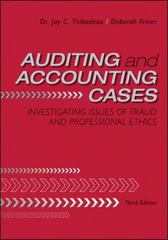Top-side adjusting journal entries are typically made by upper managers at the very end of the reporting
Question:
Top-side adjusting journal entries are typically made by upper managers at the very end of the reporting process, usually at corporate headquarters. Because these journal entries are typically not generated at the level of the business process (such as Internet sales) or at the business unit level (such as the North American division), they can be used by upper managers to circumvent the internal control system and perpetrate fraud.
According to the SEC, management at Waste Management allegedly used top-side adjusting journal entries in the process of consolidating the results reported by their operating groups. Upper management allegedly employed top-side adjusting journal entries to intentionally hide the fraud from both their operating groups and the investing public.
It was not uncommon for Waste Management to use top-side adjusting entries when consolidating the results of several of its business units to prepare its annual and quarterly financial statements. Indeed, Waste Management’s use of several unbudgeted and unsupported top-side adjustments in the early 1990s caused observers (including Arthur Andersen) to question whether management had employed these adjustments as tools to help “manage” their reported earnings. Waste Management set earnings targets during an annual budget process.
The company followed a top-down budgeting process whereby the CEO (Buntrock until 1996 and Rooney after Buntrock’s retirement until early 1997) set goals for earnings growth, and the operating units would, in turn, determine their budgets based on the goals set at the top. The budgets were then consolidated to arrive at the budgeted consolidated earnings. At this time, the upper managers also set budgets for the anticipated top-side adjustments, which were based on the existing accounting assumptions used.
Closing the Gap4 As operating results were recorded by Waste Management’s operating units at the end of each quarter, upper management monitored the gaps between the results and the goals. Management then made a number of different types of unbudgeted top-side adjusting entries in the financial statements in an effort to close these gaps. For example, a top-side adjustment might have been used to (1) reduce the allowance for doubtful accounts (or another reserve account); (2) extend the useful lives of trucks by two years; or (3) double the salvage values of trucks, depending on the nature and size of the budget gap.
Management did not disclose to investors the impact of the top-side adjustments on the company’s earnings. In fact, management did not inform its own internal operating units about the top-side adjusting entries that were made and their resulting impact on reported net income.
As early as 1992, the company’s auditor Arthur Andersen advised management against the use of top-side adjusting entries in a postaudit letter recommending accounting changes. Andersen........
Case Questions
1. In your own words, explain what is meant by a top-side adjusting journal entry. If you were auditing Waste Management, what type of documentary evidence would you require to evaluate the propriety of a top-side adjusting journal entry?
2. Based on the case information, do you think this paragraph relates to the use of top-side adjusting journal entries at an audit client like Waste Management in any way? Why or why not?
3. Do you believe that the period-end financial reporting process should always be evaluated by auditors as a significant and material process during an audit of internal control? Why or why not?
4. Identify one specific control procedure that could be designed to prevent or detect a misstatement related to a top-side adjusting journal entry.
Step by Step Answer:

Auditing And Accounting Cases Investigating Issues Of Fraud And Professional Ethics
ISBN: 9780078110818
3rd Edition
Authors: Jay Thibodeau, Deborah Freier





